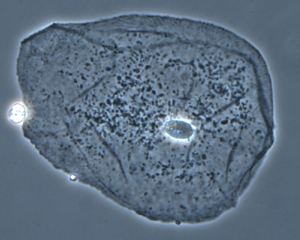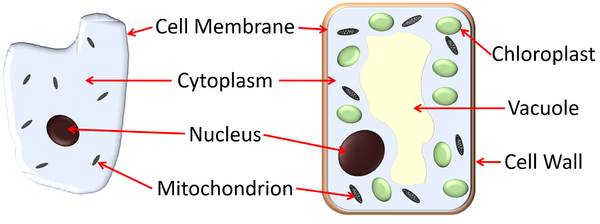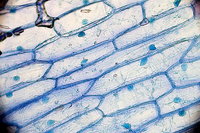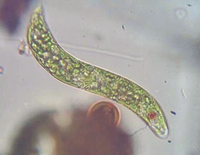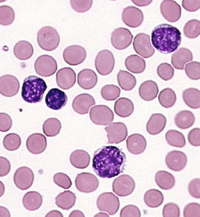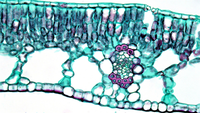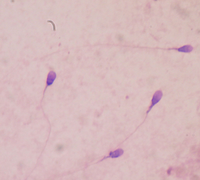Cell (Biology)
Key Stage 3
Meaning
A cell is the smallest living part of all living things.
About Cells
- Cells cannot be seen with the naked eye. You need a microscope to see them.
- Every living thing is made of cells but not all cells are the same.
- Cells are made of smaller parts:
- Cell Membrane - Controls what goes in and out of a cell.
- Cell Wall - Protects the cell and allows them to keep their shape.
- Chloroplasts - Produces food for a cell using photosynthesis.
- Cytoplasm - A jelly-like substance where chemical reactions take place.
- Mitochondria - Where respiration takes place.
- Nucleus - Controls the activities of the cell and contains the DNA.
- Permanent Vacuole - Stores cell sap.
- Plant Cells and Animal Cells made of some different parts.
- All cells have cytoplasm and a cell membrane
- Both Animal Cells and Plant Cells have a nucleus and mitochondria.
- Only Plant Cells have chloroplasts, a cell wall and a permanent vacuole
| An Animal Cell on the left and a Plant Cell on the right. |
Examples
| The cells in an onion stained blue. | Muscle cells stained pink. | A single celled organism called a Euglena that is green because of the chlorophyll inside. |
| 4 White blood cells stained purple surrounded by several red blood cells. | Several different types of plant cell found in a leaf. | Sperm cells stained purple and shown under a microscope. |
Key Stage 4
Meaning
A cell is the smallest living part of an organism.
About Cells
- Cells can be divided into two main groups Eukaryotic Cells, which contain membrane bound organelles, and Prokaryotic Cells which do not contain membrane bound organelles.
About Cells
- Cells cannot be seen with the naked eye. You need a microscope to see them.
- Every living thing is made of cells but not all cells are the same.
- Cells are made of smaller parts:
- Cell Membrane - A selectively permeable membrane which controls what goes in and out of a cell.
- Cell Wall - Protects the cell and allows them to keep their shape.
- Chloroplasts - Produces food for a cell using photosynthesis.
- Cytoplasm - A jelly-like substance where metabolic processes take place.
- Mitochondria - Where respiration takes place.
- Nucleus - Controls the activities of the cell and contains the DNA.
- Permanent Vacuole - Stores cell sap.
- Ribosomes - The areas of protein synthesis in the cells.
- Plant Cells and Animal Cells made of some different parts.
- All cells have cytoplasm and a cell membrane
- Both Animal Cells and Plant Cells have a nucleus and mitochondria.
- Only Plant Cells have chloroplasts, a cell wall and a permanent vacuole
| An Animal Cell on the left and a Plant Cell on the right. |
Examples
| The cells in an onion stained blue. | Muscle cells stained pink. | A unicellular organism called a Euglena that is green because of the chlorophyll inside. |
| 4 White blood cells stained purple surrounded by several red blood cells. | Several different types of plant cell found in a leaf. | Sperm cells stained purple and shown under a microscope. |
Beyond the Curriculum
Exploring the Intriguing World of Cells
Cells, as you've learned in your biology classes, are the fundamental building blocks of life. But did you know that there's a whole world of fascinating facts about cells that go beyond the standard curriculum? Let's delve into some exciting scientific tidbits and concepts that are usually reserved for university-level science courses.
Cell Diversity
While your textbooks may focus on the basics of animal and plant cells, the realm of cell biology is incredibly diverse. There are numerous types of cells that serve unique functions. For instance, nerve cells, also known as neurons, transmit signals in your body at astonishing speeds. Blood cells, such as red blood cells and white blood cells, play vital roles in oxygen transport and immune defense. Explore beyond the classroom to discover the incredible variety of cells that exist and their specialized functions.
The Intricate World of Organelles
Inside a cell, organelles are like tiny machines, each with a specific job. While you're likely familiar with organelles like the nucleus and mitochondria, there are lesser-known ones that are equally intriguing. Consider peroxisomes, which are involved in breaking down fatty acids and detoxifying harmful substances. Or centrioles, which play a crucial role in cell division. These organelles are like the unsung heroes of the cell world, working tirelessly behind the scenes.
Cellular Communication
Cells don't operate in isolation; they communicate with each other to coordinate activities. One remarkable aspect of cellular communication is through gap junctions. These tiny channels allow adjacent cells to exchange ions and small molecules directly, enabling rapid coordination in processes like heart contractions. Understanding these communication methods sheds light on the remarkable teamwork that occurs within our bodies.
Beyond the Microscope
While microscopes are essential tools for studying cells, some cutting-edge research techniques take us even further. Techniques like fluorescence microscopy allow scientists to visualize specific molecules within a cell, revealing intricate details of cellular processes. Advanced imaging technologies, such as electron microscopy, provide unprecedented clarity in observing the ultrastructure of cells, revealing their inner workings with incredible precision.
The Frontiers of Cell Research
Cell biology is a rapidly evolving field, and researchers are continually making groundbreaking discoveries. For example, recent studies have uncovered the role of CRISPR-Cas9 gene editing in manipulating cell DNA, opening up possibilities for genetic therapies. The study of stem cells, which can develop into various cell types, holds promise for regenerative medicine. These are just glimpses of the exciting frontiers where scientists are pushing the boundaries of our understanding of cells.
Cell Memory and Epigenetics
Beyond the traditional curriculum, there's a captivating field known as epigenetics. It explores how cells carry a form of "cellular memory" that influences their behavior. Imagine a cell as a tiny computer with a memory chip. Epigenetic marks, like bookmarks in a book, can be added or removed over time. These marks affect which genes are "read" or activated within a cell. This dynamic process plays a pivotal role in development, aging, and even diseases.
Researchers are uncovering the remarkable ways in which environmental factors, lifestyle choices, and experiences can leave lasting imprints on your cellular memory. The study of epigenetics challenges traditional notions of genetic determinism, highlighting the intricate interplay between nature and nurture in shaping who we are.
Incorporating these captivating facts and concepts into your knowledge of cells can provide you with a deeper appreciation of the remarkable world of biology. While these topics may not be part of your school curriculum, they showcase the ongoing quest for knowledge in the scientific community and inspire you to explore further. Who knows, you might just be the scientist to make the next groundbreaking discovery in cell biology!
